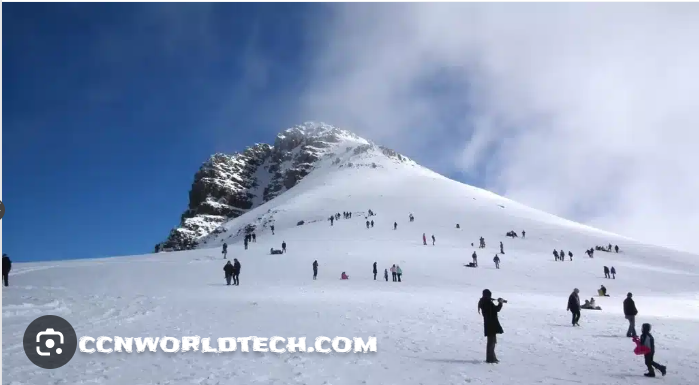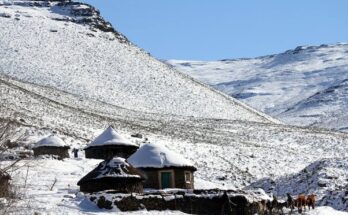Whether it snows in Africa or not isn’t supposed to be a subject of debate. Based on verifiable climate data, what we should instead debate is how much it snows in Africa and which African countries experience the most snow.
Undeniably, it snows in Africa but we might not want to compare the degree of snow in Africa to that of Europe or even North America. Before we delve further into Africa’s experience of snow, let’s consider the reason why some people may have had the thought that it doesn’t snow in Africa.
Well, it’s normal for many Africans to suppose it doesn’t snow in Africa, simply because it snows less in Africa; majority of African countries do not experience snow. Temperatures need to get very low before snowing may result, and because it is not very common for temperatures to reach or go below 0°C in Africa, most countries on the continent can barely experience snowfall.
⇒Join us on Telegram for more Sure and Accurate football-winning tips every day...click here
Now that we’re clear on why some people may think it doesn’t snow in Africa, it is worthy of note to discuss the places where snowfall occurs in Africa.
What Are the Top 10 African Countries Where It Snows?
South Africa
South Africa is most probably the most notable country where it snows in Africa. While South Africa’s experience of snow is nothing near Europe’s, we actually can’t deny that the country’s Northern Cape and Western Cape do experience snow annually.
South Africa’s cold regions, where it eventually snows, include Cape and Drakensberg. Particularly, the country’s Drakensberg Mountains is considered one of the hotspots of snowfall in Africa. The temperature in such regions can go as low as 4°C. The season of snow in South Africa’s snowy regions lasts between June and August.
Notwithstanding that South Africa experiences the most amount of snow in Africa, it is worth noting that only few South African regions experience snow. And in these regions, every year seems to come with a minimum of five snowy days.
Algeria
Algeria is another African country with a history of snowfall. Just like South Africa, Algeria is home to regions where the temperature can get so extremely low that snow eventually emerges.
Setif is one of such regions, and records show that in January, Setif’s low temperature may plunge to less than 3°C –a situation that results in days of snowfall. Setif experiences about 147 millimetres of snowfall in February which is regarded as its peak month of snowfall.
Batna is another snow-prone region in Algeria. Annually, this region experiences about 166 millimetres of snow. Though this falls far below Setif’s annual estimate of 403 millimetres, there’s no doubt that Batna is also a major region where it snows in Algeria.
Annually, Batna and Setif experience snowfall for about 15 days and 22 days respectively.
Tunisia
Tunisia, and most probably all other countries where it snows in Africa, has a diverse climate. So, the country’s regions are not expected to have the same atmospheric pattern.
During winter in Tunisia, the temperature in the snow-prone regions can plunge to 5°C. This snowy period lasts between December and February in such regions like Jebel ECH Chambi and Jebel Zaghouan.
On the one hand, Tunisia borders upon the Mediterranean Sea, and on the other hand it borders upon the Sahara Desert, and this may explain why the country has a really diverse climate.
The snow in Tunisia can be specifically sighted across mountain tops, meaning the country’s alpine regions are the hotspots of snowfall.
Morocco
Morocco is characterized by variety in climate conditions across its zones including the Mediterranean, the highlands, sub-Mediterranean and semi-arid zones. The country is home to the Atlas Mountains which is regarded as the most notable hotspot of snowfall in Africa.
The country’s north and central zones seem to experience days of snowfall between December and February. Records indicate that during the peak of winter in Morocco, temperatures in the most-hit region(s) may plunge to -5°C.
As earlier implied, Morocco’s zones seem to experience differing temperature ranges: the sub-Mediterranean zone earmarks 27°C-40°C, the continental zone experiences 32°C-360°C, and the Mediterranean zone records 29°C-32°C.
Geographically, Morocco is close to Europe, thanks to its proximity to Spain. The North African country also sits between the Atlantic Ocean and the Mediterranean Sea. We may infer that this geography contributes to Morocco’s experience of snowfall.
Lesotho
Lesotho’s annual estimate of snowfall can reach 13 millimetres. Notwithstanding that this estimate is very low compared to those of South Africa and Algeria, the truth we shouldn’t deny is that Lesotho is a snow-prone African country.
In Lesotho, the cold –or winter –period may last between June and August, with the peak temperature said to go as low as 0°C. Also, Maseru is known to experience snow annually.
Snowfall occurs across some of Lesotho’s highlands from June to August.
Ethiopia
Ethiopia is endowed with a number of high mountains, and its status as a snow-prone country may be attributed to these mountains.
Ethiopia’s northern mountains experience sizeable amounts of snowfall annually, with the Amhara Region considered a hotspot of snowfall. This region is home to the Simien Mountains National Park.
Namibia
Namibia has a relatively low amount of snowfall, which occurs during the country’s “cool dry” season.
While the country’s “cool dry” season is said to last longer than its “hot wet” season, Nambia’s period of snow may be characterized by low morning and night temperatures capable of further declining into snow.
Tanzania
Tanzania features in our list (of the 10 countries where it snows in Africa) only for one reason: it is home to Mount Kilimanjaro. It’s worth noting that this mountain’s experience of very low temperatures cuts through the year, but most especially in June, July, August, September and December.
During the peak of cold, Mount Kilimanjaro’s temperatures can plunge to -15°C. While the level of rainfall differs between the mountain’s northern hemisphere and the southern hemisphere, with the former recording less rainfall, Mount Kilimanjaro reportedly experiences a high degree of cold in Africa. Quite interestingly, it is also regarded as Africa’s tallest mountain.
Kenya
That we included Kenya in our list of African countries where it snows does not mean you’ll have a great sight of snowfall during winter, irrespective of where you are in Kenya.
Kenya’s experience of snow may be attributed to Mount Kenya which is characterized by high elevation. This mountain experiences rain and snow in great amounts. December is one of months you may expect it to snow on Mount Kenya.
Uganda
Just like Tanzania and Kenya, Uganda rides on the strength of its mountain to win a spot in our list of top 10 African countries where it snows. Thanks to its Rwenzori Mountain, Tanzania experiences snow which may plunge to -5°C.
The Rwenzori Mountain is characterized by the fall of snow, ice and glaciers. It is one of the regions where it is known to snow in Africa.
As for the widespread of snowfall, the likes of Uganda, Kenya and Tanzania do not come near South Africa, Morocco, and Algeria. This is because the former group of countries does not seem to experience snow in places other than mountains.
FAQs
Does snow fall in Africa?
Some Africans, especially those in countries where harmattan is the alternative to winter, may think it doesn’t snow in Africa at all. It is quite fascinating that it snows in (some parts of) Africa, but not as much as it snows in Europe.
In actuality, snow falls in Africa and certain African regions and mountains are known to experience snow over a stretch of months annually.
Where in Africa does it snow?
We may comfortably argue that less countries experience snow in Africa, but every year and in specific months, it snows in African regions, including the Atlas Mountains (Morocco), Setif (Algeria), Drakensberg Mountains (South Africa), Jebel ECH Chambi (Tunisia), Mount Kilimanjaro (Tanzania), Mount Kenya (Kenya), Rwenzori (Uganda), Maseru (Lesotho), etc.
South Africa’s Drakensberg, Algeria’s Setif and Morocco’s Atlas Mountains have been particularly touted as hotspots of snowfall in Africa, with the Atlas Mountains distinguished as the most notable hotspot of snowfall on the continent.
Which African country experiences the most snow?
We may not be able to exactly state the African country with the highest amount of snowfall, as countries like Morocco, South Africa and Algeria seemingly experience relatively high levels of snow yearly. However, we do know that Morocco is home to the Atlas Mountains which is regarded as the most notable hotspot of snowfall in Africa.
Meanwhile, South Africa’s Drakensberg Mountains is considered one of the hotspots of snowfall in Africa. The temperature in this region can go as low as 4°C. Snow in South Africa’s snow-prone regions lasts between June and August.
Does it snow in African regions other than Northern Africa?
Yes, it does. While North African countries like Morocco, Algeria and Tunisia are known to experience snowfall, they are not the only African countries with such experience. South Africa experiences a relatively high degree of snow, making it one of the major African countries where snow falls.
Other countries outside North Africa where snow falls include Namibia, Ethiopia, Uganda, Tanzania, Kenya, and Lesotho. Some of these countries specifically have mountains that are characterized by annual snowfall. Tanzania’s Mount Kilimanjaro, for instance, experiences very low temperatures which cut through the year, especially in June, July, August, September and December. In the peak of cold, Mount Kilimanjaro’s temperatures can plunge to -15°C.
Conclusion
Most African countries do not experience winter which is, by tradition, the season of snow. Though characterized by coldness, harmattan which is more common than winter in Africa, doesn’t bring about snow. By inference, snow is not expected to fall in most African countries since they do not experience winter.
If you live in one of African countries like Nigeria, Ghana, Togo, Senegal, etc. and have not been to North Africa or even places like South Africa, Namibia, etc., you may have shared in the thinking that it doesn’t know in Africa.
However with the insightful information we’ve shared in this post, we do hope that you’re now convinced that it snows in Africa, though in few countries. Moreover, some of these (few) countries tend to experience higher rates than others. Based on our findings, Morocco, South Africa and Algeria, in no particular other, lead the pack, while the experience of snow in some countries seems to occur only on certain mountains. Mount Kilimanjaro is touted as the only place where snow falls in Tanzania. While its experience of very low temperatures especially happens in June, July, August, September and December, Mount Kilimanjaro’s temperatures can plunge to -15°C.
If you have some thoughts to share about the countries that experience the most snowfall in Africa, do let us know in the comment section.




